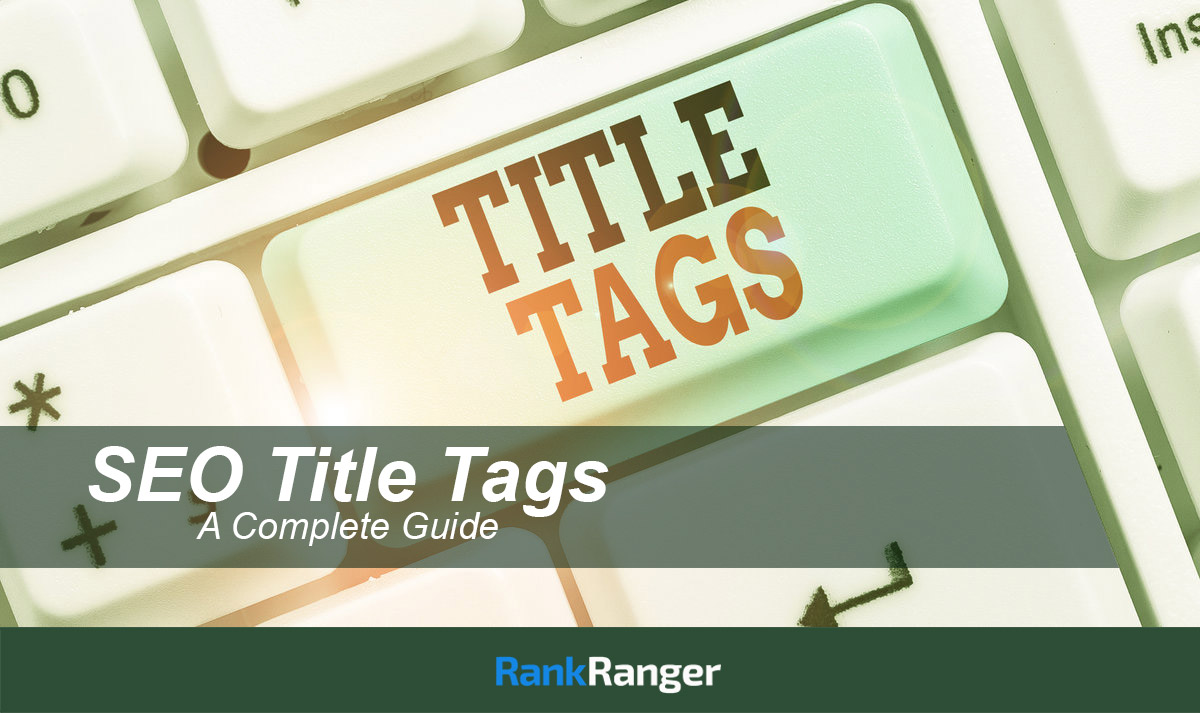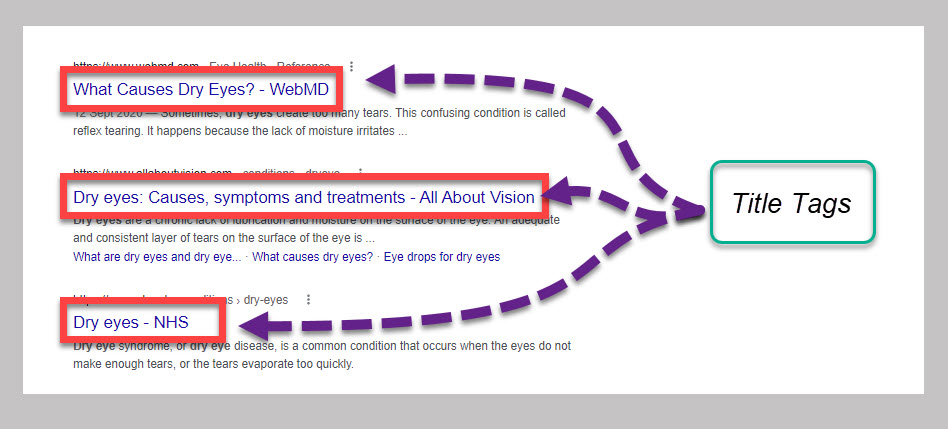The importance of SEO cannot be stressed enough, or more precisely, the organic traffic that SEO brings.
The reasons are pretty simple. If you venture into an online business, SEO is there to enhance customer traffic and raise your reputation, giving you an advantage on the market.
But SEO is mathematics, and it has a proper way of doing things, which includes various technical details. One of those details is title tags.
So, the question then follows – why are title tags so crucial for building your on-page SEO?
First things first, if you didn’t know by now, you should learn what title tags are and what’s their primary function. Title tags are coded HTML tags that involve selecting a specific title for a website. The location of the title tag is always on the title bar of the selected browser and the Search Engine Result Page, or in short – the SERP.
This was a simple explanation of what precisely SEO title tags are. We’re going to discuss the significance of title tags for organic SEO traffic in-depth below.
Where Do Title Tags Appear?
Properly structured title tags will display on Google’s and Bing’s search results, listed as page titles. This, in turn, implies that title tags are crucial in terms of organic SEO and promoting your own website. The initial impression of your clientele on your website is formed by these title tags, and you’ll greatly benefit from establishing a powerful first impression.
However, do bear in mind that the title tag will display itself in different areas as well. Along with the tab of your web browser, title tags appear on sites for social media when users post a link to that website. Concurrently, social networks and browsers snatch the title for the sole purpose of showing people what the page is all about.
So, to sum up, title tags appear in three major locations:
- Browsers
- SERPs
- Posted links on social media sites
On a side note, title tags are sometimes referred to as meta titles or meta title tags.
Don’t get confused – you’ll soon assemble all pieces of the puzzle.
The Ordeal of Making Your Title Tags SEO-Perfect
Stressful is quite an understatement when striving to create an SEO-perfect title tag. Many small components can get you to sway off track on building up an organic SEO meta title because of the algorithmic rule the search engines work with.
When talking about small components, title tags are one of them, but they sure pack a punch on building up your organic SEO content. An initial thing to stay focused on is that keywords are mandatory within the title tag itself. In the long run, this aids Google’s AI to see which exact keywords you’re optimizing to get the gist of what they search for, and what results to display.
So, let’s see what optimization techniques you should use for meta title tags to bring that organic SEO traffic your way.
Create a Proper Title
Be careful about the length of your title tags as search engines tend to substitute them with ellipsis, attach some extra words, or even change it with a full-blown rewrite.
A title below sixty characters is the most appropriate length, but search engines are a little bit tricky since they work with a 600-pixel limitation. This is why some lengthy characters, such as the letter “W,” take up more pixels than, let’s say, the letters “I” and “J.” So, if your title is with extended characters, keep it even lower than the 60 character threshold because search engines can’t provide enough space for the whole title tag.
Because of this, 40 characters are more or less the ideal length of a title tag.
Another thing to note is that you shouldn’t be using “all caps” title tags. This can prove challenging for search engines to analyze appropriately, and Google will massively restrict the characters’ numbers. Sometimes, even with the amount of effort you’ll put on the correct length of the title tag, Google might shorten it to exhibit a contrasting length.
However, keep in mind that not every longer title is a bad one. For instance, a social media web page title is better off being lengthy, and sometimes you can’t shorten it as it’s organically extended. Most of the time, there isn’t a good or a bad length of a title – just optimize it the way you think it should look as if you’re the one searching for it.
Make Your Title Tags Distinctive
This topic is as straightforward as it goes. When it’s SEO in question, writing down a unique and distinctive title tag is the way to go because it shows the unique nature of your webpage.
Additionally, this will help out with click rates by people who search out your distinctive title. Considering there are thousands upon thousands of distinctive title tags, it’s not an easy task to come up with the appropriate title you’re going to implement. But don’t fret, as there are great content management systems (CMS) for you to get a hold of a distinctive title frame.
If your game is listing multiple products and categories, then these templates will work wonders. A great thing to note is avoiding backtracking on generalized titles such as “Home page” or “new page.” By doing this, Google will think you’re duplicating the content that’s published on your website, or even other sites for that matter. Your click-through rates will dramatically decrease if you use these generic titles.
Think about it, would you ever click a Google result with a vague title?
How to Design your Title Tags
First and foremost, title tags with “stop words” such as; and, a, but, for, or, the, with, was should be evaded as much as possible. It will be a bit of a hassle but try organizing your title tag differently. By investing some effort, you will definitely come up with a unique title without using these words.
Additionally, even if these words prove to be of no good use, there are certain words that are actually beneficial to implement. Words that describe some sort of action, as in get, learn, go, make, boost, and so forth, aid with the click-through rates of your clientele. Keep in mind to add just enough information in the title tag to match the meta title description as not to confuse the users.
Furthermore, primary keywords and secondary keywords followed up by the name of your brand is an accurate way of describing your title tag for a great SEO buildup. Don’t disregard symbols like plus signs and hyphens, ampersands, and the standard commas and full stops since you can put them to good use.
You can even implement question and exclamation marks in your title tag because most of the time, search engines disregard them, and they won’t mess up your meta title whatsoever. Overusing these symbols and punctuations for two or three multi-word purposes in your title tag isn’t a good idea.
Differentiating between the headings of your title tag and the title on your website is another crucial thing to note. Using a dissimilar heading at the on-page title to get an even bigger impact on the keywords you’re trying to target will prove to give an SEO advantage.
Minimize The Keywords In Your Title
Don’t over-exaggerate your keywords in titles so they can rank up high within organic SEO traffic. Overstuffing keywords in your title is not just bad for SEO; it’s also aesthetically unpleasing. The length of your title might as well slide through search engines, but bulking up keywords as you please is an absolute no-no. As time goes by, search engines and their algorithms evolve, and even if you change the order of your keywords, they’ll still find it and punish you.
Prioritize your Primary Keywords
Lots of research has been made on this topic, and the general conclusion is that primary keywords should be written as close to the starting point of the title tag as possible.
This is because most people will only notice the first two words of your title tag. So, inserting those two keywords is an ideal way of receiving more traffic. So, if you’re listing products, that will be your primary keyword, and as such, it ought to be the first word in sight.
Let’s change perspectives for a while and say that you’re the customer looking for a product on a search engine.
Imagine that you want to buy JLB earphones. Naturally, you’re going to write something like “earphones JBL.” The name of your product will pop out first, along with all the other earphones they have.
It’s a matter of writing the title tag exactly as users want it to be listed. Because, if you put earphones at the end, and before the search result for earphones, you list out the major and minor categories of the product. So, most people will overlook “earphones” as it’s at the end of the title tag. Moreover, if the primary keyword is at the end, Google or Bing might even leave it out, and if you have a lot of primary keywords in the title, it might even get completely rewritten.
Make The Most of Your Branding
If you have a brand that you want to advertise, a good way of doing that is by adding its name to your title tag. This helps out with the click rates but do keep in mind that it’s better for your brand to be at the end of the meta title.
Nonetheless, if you’re making a title tag for your home webpage, it’s good for the name of your brand to be placed at the beginning. Sometimes, search engines and content management systems may even automatically exhibit the brand name in your title so be wary of how it’ll come up when the title tag is searched for.
See Through Your Clients’ Eyes
We’ve seen how title tags are absolutely crucial for building up organic search engine optimization. But in the end, organic SEO from title tags will flush through the drain if there’s not a single client looking for it.
As a general note, organizing your title tag through the clients’ eyes is one of the major steps for getting an SEO-perfect title tag. So, opting for crucial information in your title tag with the clientele in mind is paramount because that will be their first impression before deciding to go through with your link.
Even if your title tag is adequate enough to reach SERP’s high ranking, it won’t receive any click-throughs if it’s written without considering your clients. Moreover, be honest with the title tag. Clickbait is a no-no, and we’ve discussed how vague meta titles won’t get you anywhere fast.
If the keywords you put in your title tag don’t align with what you’re offering on your website, most of the clients will just leave and head directly for the next choice they see.
Final Takeaway
As title tags are one of the most elementary parts of SEO, they’re actually one of the most essential things for organic SEO. Ninety percent of the time, the traffic and click-through rates that you’ll receive are thanks to the good title tag you’re going to implement.
There are a lot of SEO tools to aid with finding out what the ideal title tag should look like. For a full-blown search engine optimization – you must pay attention to title tags!
If you’re just starting out with SEO and feeling confused about title tags, meta descriptions, and all the other terms, check out our title tag preview tool.










